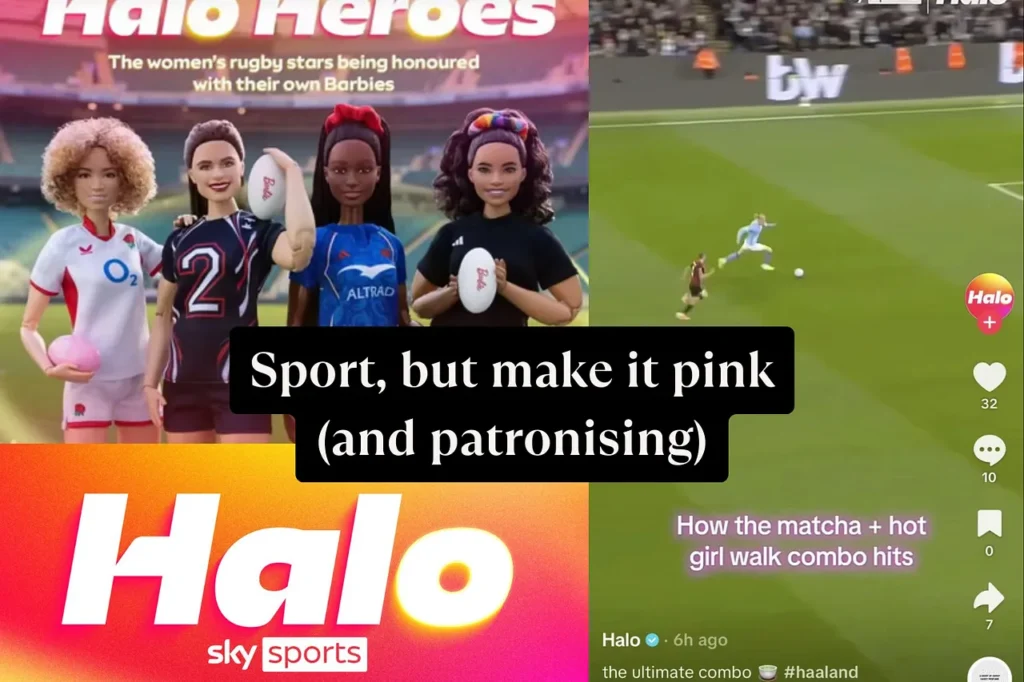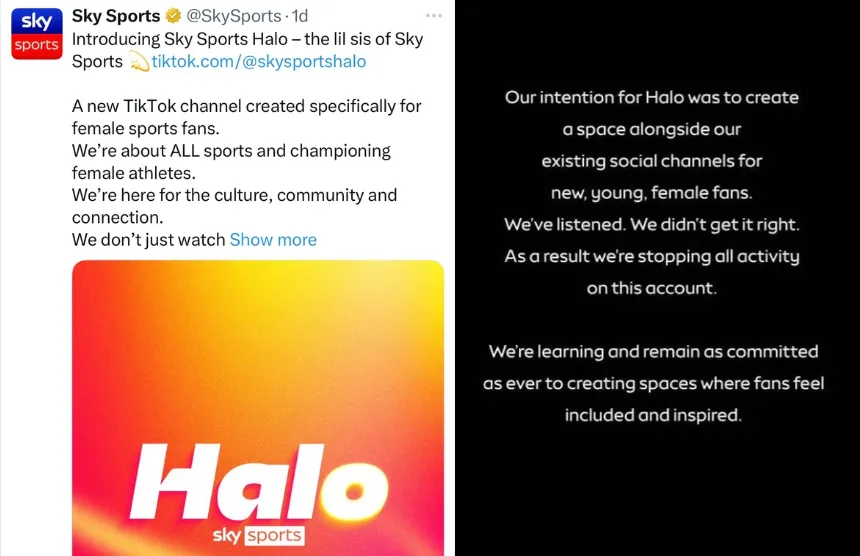Have you ever watched a sports broadcast and thought, “You know what this needs? More pink subtitles and sparkle emojis!” — good news, so did Sky Sports.
Last week, Sky Sports launched a “female-friendly” TikTok account called Sky Sports Halo — branded as their “Lil Sis” feed — complete with pink text, sparkly fancam emojis, “hot girl walks”, matcha references, and reductive lifestyle comparisons. It lasted roughly 48 hours before being shut down with a statement that read like the brand equivalent of a notes app apology.
This wasn’t just a tone-deaf marketing fail. It was a case study in how women are continually infantilised and sidelined in male-dominated spaces — including sport. Instead of addressing the real barriers women face (harassment, gatekeeping, misogyny, exclusion), the solution offered was pink paint and girlification.
An enduring reminder that brands still think engaging women means creating a separate, softer, sillier universe… instead of fixing the main one.
When brands hear “women want inclusion”, Sky Sports hears “make it pink!”
When Sky Sports launched Sky Sports Halo, it introduced it as “the lil sis of Sky Sports… created specifically for female sports fans… here for the culture, community and connection”.
Within days, it went viral—and not in the way Sky hoped. Women, especially across F1, football and cricket fandoms, immediately recognised it for what it was: not genuine inclusion, but a patronising caricature of what men think women like.
The account is now deleted. But the mindset that produced it is very much alive.

Halo wasn’t just a misstep. It was a case study in how mainstream sports media still treats women as an afterthought, a niche audience, or a monolith—rather than existing fans with diverse interests, deep knowledge, and legitimate criticisms of how they’re treated.
And for an account that lasted roughly 48 hours days, it managed to pack in an extraordinary amount of wrong.
Pink writing, emojis and matcha: ah, finally sport makes sense!
From the outset, the tone was condescending. “Lil sis” isn’t a cute branding choice—it positions the main Sky Sports feed as the “real”, serious, authoritative channel and women as younger, sillier, and in need of simplified (and yassified) content.
Then came the aesthetics: pink sparkly text, fancam tropes, matcha memes, “hot girl walk” jokes. It was sports reframed as memefied lifestyle fluff for an audience presumed unable (or unwilling) to handle analysis and commentary.
The whole thing felt like someone took the Barbie scene where the Kens mansplain The Godfather, bottled it, and poured it onto TikTok. It wasn’t inclusive. It was reductive.
And then there was the actual content (what little of it there was). Halo claimed it was here to “champion female athletes”. Yet five of the first 11 posts featured men. This isn’t surprising when you look at Sky’s main feed, where women’s sport remains a side-note.
The unspoken logic seemed to be “sport = men, but we’ll give you 50% women on your silly little girlypop channel, because, equality”.
It’s the same logic that led to “shrink it and pink it” product design: a surface-level solution that avoids confronting the real issue, and requires zero self-reflection or cultural change.
FFS, can women please just watch sport without being infantilised?
Let’s be clear: women aren’t asking for a side-channel, simplified content or to be treated like silly little girls who couldn’t possibly understand the rules.
We’re asking for respect, safety and visibility.
We want to be treated as equal participants and genuine consumers of sport. We want analysis that doesn’t assume we’re outsiders who need sports “translated” into matcha, gossip, and sparkle emojis.
The impulse behind Halo reflects a bigger misunderstanding: that inclusion means creating separate spaces for women rather than improving the main one.
Women don’t feel excluded because the content isn’t “girly” enough; they feel excluded because they’re routinely harassed in comment sections, ignored in editorial decisions, spoken over in analysis, and dismissed as “fake fans” or just watching to objectify the male athletes.
When women say, “sports media feels hostile,” brands hear “please make it pink”.
What we’re actually saying is: Stop the gatekeeping. Stop the misogyny. Stop assuming we don’t belong here.
Of course, it was capitalism all along
Halo exposed a deeper truth: brands want the market segment without addressing the culture.
They see a growing female audience (F1 is a prime example) and they want to monetise that attention without challenging the exclusion, harassment and misogyny that push women out.
So instead of fixing the main feed, they build a sparkly pink side-room and call it empowerment.
The speed and scale of the backlash — including from men — is a hopeful sign that this kind of pinkwashing is losing steam. But the fact that it launched at all shows how far the industry still has to go.
If Sky Sports genuinely wanted to engage women, they should start with structural improvements, not aesthetics.
It would look like:
- Investing in female commentators
- Giving women’s sport equal production value and promotion
- Moderating sexist abuse in comment sections
- Addressing misogyny in sports culture rather than pretending it’s incidental
- Fixing the main feed instead of pushing women into a separate one
Women’s biggest barrier to sports engagement has never been “not enough pastel content”.
It’s the culture.

This isn’t a one-off; it’s everywhere
Halo is just the sports-shaped version of a larger cultural pattern:
- In politics: “women’s panels” instead of policy reform
- In workplaces: wellness events instead of pay equity
- In media: female-only verticals instead of newsroom diversity
Dedicated women’s spaces can be valuable. But too often, they’re deployed instead of structural change. The gender-equity equivalent of an IWD morning tea with pink cupcakes that women themselves had to buy, set up and clean up.
The account may be gone, but the thinking isn’t
Sky Sports Halo wasn’t an isolated mistake. It was a mirror held up to an industry that still hasn’t done the work of meaningfully engaging women.
It tried to attract female fans without respecting them.
It tried to create inclusion without equity.
It tried to fix the optics without fixing the culture.
Women called it out instantly — because we’ve seen this playbook before.
The account is gone. The mindset isn’t.
And until that changes, no amount of pink text overlays will help.
You can subscribe to Lauren’s newsletter, Notes on Nuance here.

